Nurse Handovers: Factors, Interventions, and Patient Safety Report
VerifiedAdded on 2020/05/16
|28
|7658
|66
Report
AI Summary
This report, based on a literature review, focuses on the critical role of nurse handovers in maintaining patient safety during shift changes. It investigates the factors that contribute to ineffective handovers, such as lack of proper training and standardization of protocols, which can lead to miscommunication, omissions of vital patient information, and medical errors. The report highlights the importance of effective communication during patient handovers and explores various interventions, including proper training, education of nurses, and the establishment of standardized handover protocols, to prevent adverse patient outcomes. The study utilizes both quantitative, qualitative, and quasi-experimental studies to comprehensively analyze the issue, emphasizing the need for improved handover practices to ensure patient safety and improve overall healthcare quality.
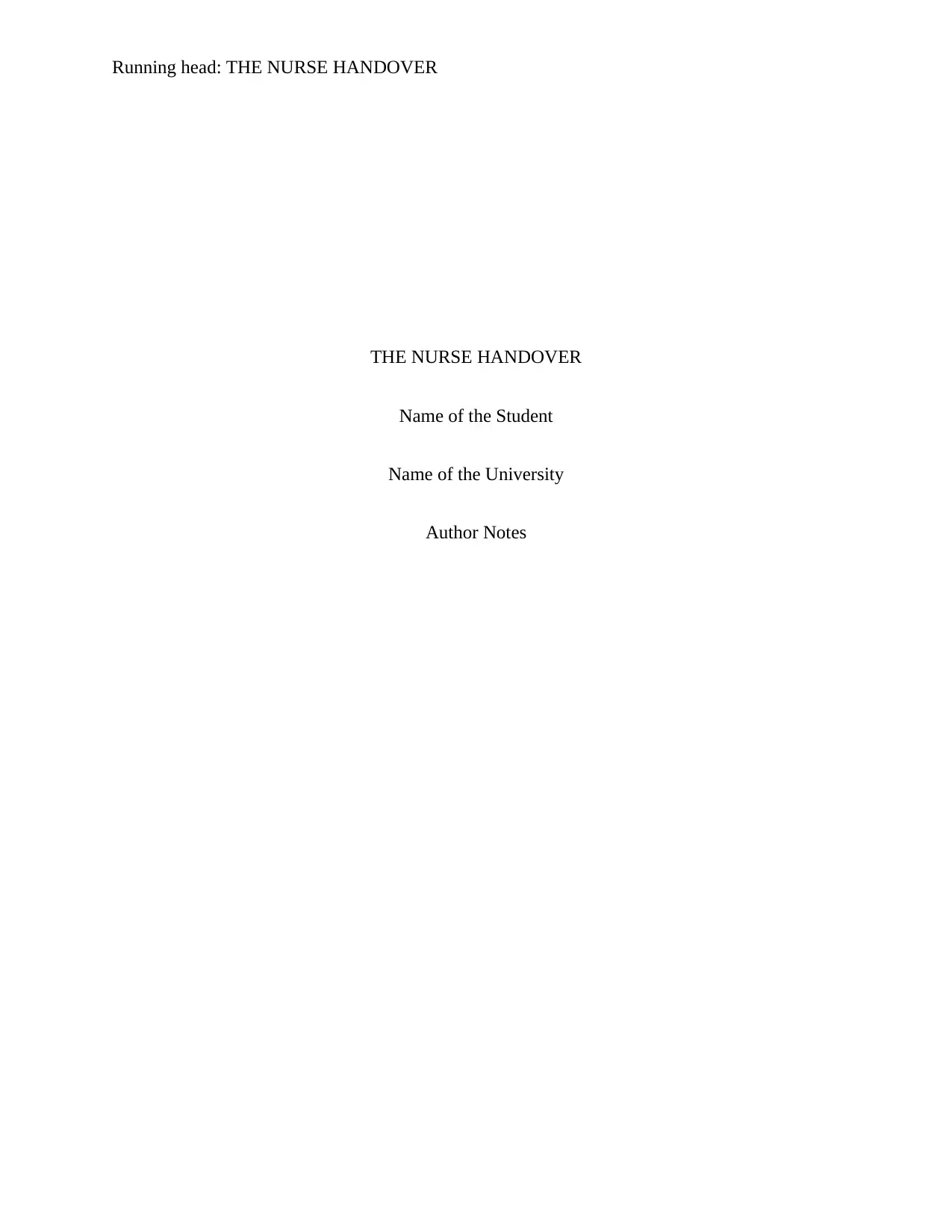
Running head: THE NURSE HANDOVER
THE NURSE HANDOVER
Name of the Student
Name of the University
Author Notes
THE NURSE HANDOVER
Name of the Student
Name of the University
Author Notes
Paraphrase This Document
Need a fresh take? Get an instant paraphrase of this document with our AI Paraphraser
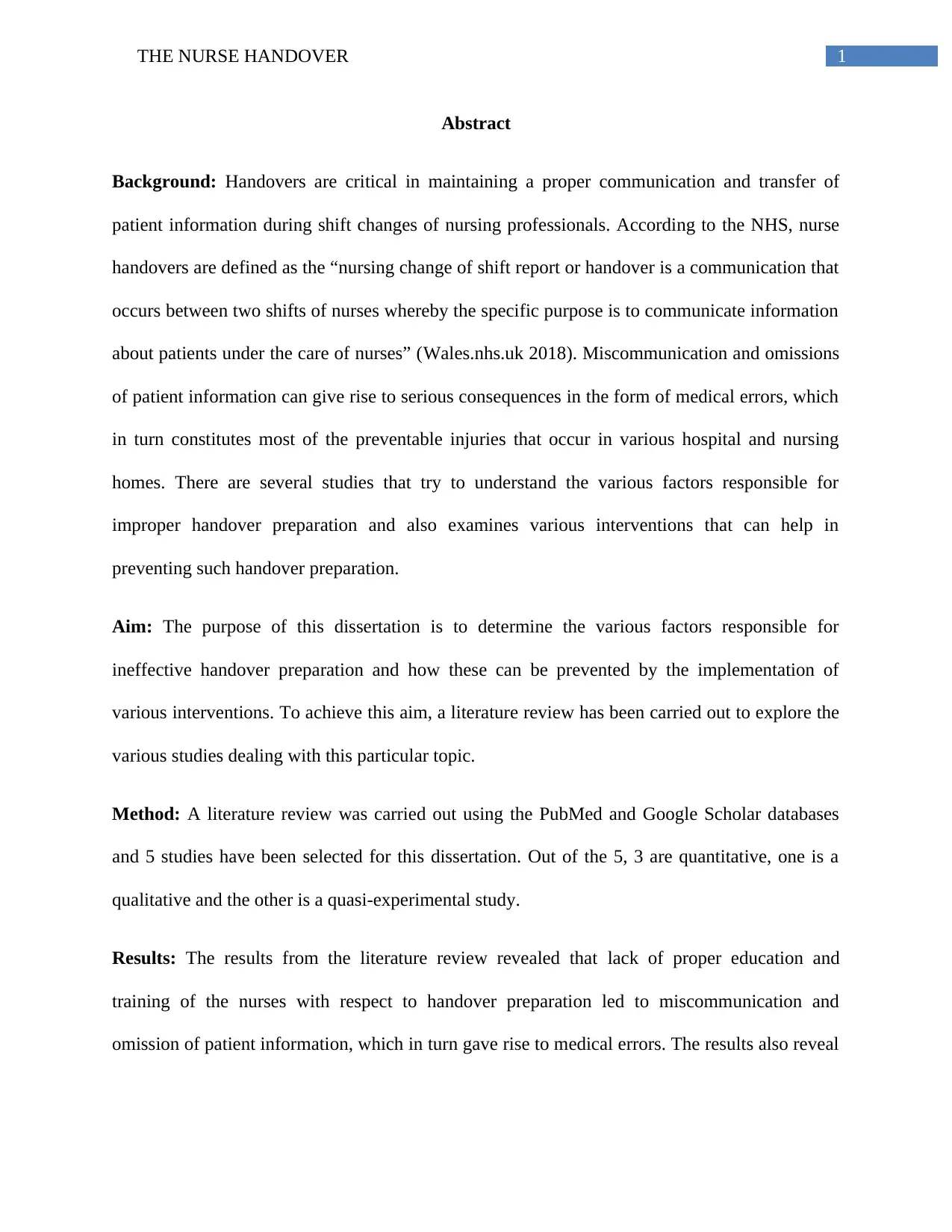
1THE NURSE HANDOVER
Abstract
Background: Handovers are critical in maintaining a proper communication and transfer of
patient information during shift changes of nursing professionals. According to the NHS, nurse
handovers are defined as the “nursing change of shift report or handover is a communication that
occurs between two shifts of nurses whereby the specific purpose is to communicate information
about patients under the care of nurses” (Wales.nhs.uk 2018). Miscommunication and omissions
of patient information can give rise to serious consequences in the form of medical errors, which
in turn constitutes most of the preventable injuries that occur in various hospital and nursing
homes. There are several studies that try to understand the various factors responsible for
improper handover preparation and also examines various interventions that can help in
preventing such handover preparation.
Aim: The purpose of this dissertation is to determine the various factors responsible for
ineffective handover preparation and how these can be prevented by the implementation of
various interventions. To achieve this aim, a literature review has been carried out to explore the
various studies dealing with this particular topic.
Method: A literature review was carried out using the PubMed and Google Scholar databases
and 5 studies have been selected for this dissertation. Out of the 5, 3 are quantitative, one is a
qualitative and the other is a quasi-experimental study.
Results: The results from the literature review revealed that lack of proper education and
training of the nurses with respect to handover preparation led to miscommunication and
omission of patient information, which in turn gave rise to medical errors. The results also reveal
Abstract
Background: Handovers are critical in maintaining a proper communication and transfer of
patient information during shift changes of nursing professionals. According to the NHS, nurse
handovers are defined as the “nursing change of shift report or handover is a communication that
occurs between two shifts of nurses whereby the specific purpose is to communicate information
about patients under the care of nurses” (Wales.nhs.uk 2018). Miscommunication and omissions
of patient information can give rise to serious consequences in the form of medical errors, which
in turn constitutes most of the preventable injuries that occur in various hospital and nursing
homes. There are several studies that try to understand the various factors responsible for
improper handover preparation and also examines various interventions that can help in
preventing such handover preparation.
Aim: The purpose of this dissertation is to determine the various factors responsible for
ineffective handover preparation and how these can be prevented by the implementation of
various interventions. To achieve this aim, a literature review has been carried out to explore the
various studies dealing with this particular topic.
Method: A literature review was carried out using the PubMed and Google Scholar databases
and 5 studies have been selected for this dissertation. Out of the 5, 3 are quantitative, one is a
qualitative and the other is a quasi-experimental study.
Results: The results from the literature review revealed that lack of proper education and
training of the nurses with respect to handover preparation led to miscommunication and
omission of patient information, which in turn gave rise to medical errors. The results also reveal
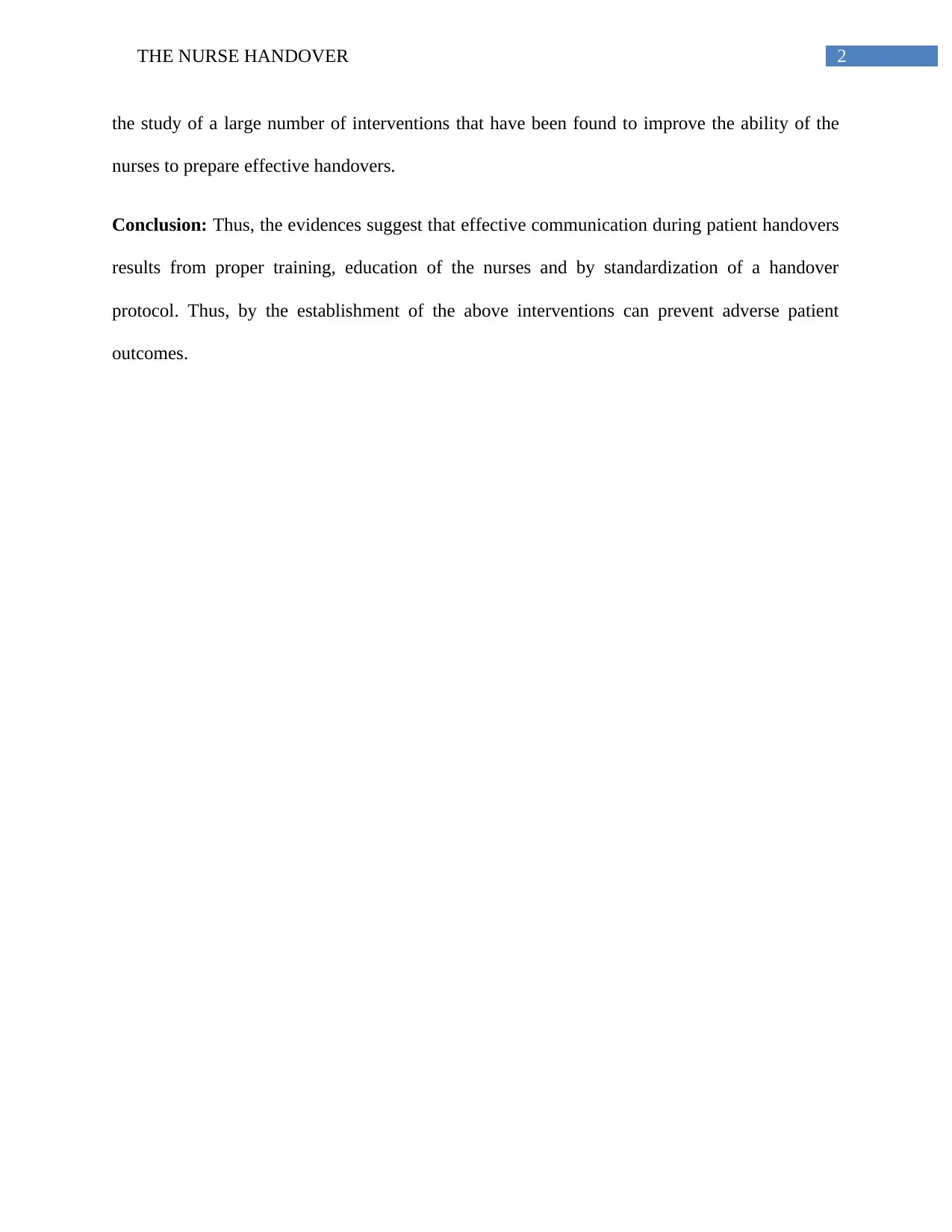
2THE NURSE HANDOVER
the study of a large number of interventions that have been found to improve the ability of the
nurses to prepare effective handovers.
Conclusion: Thus, the evidences suggest that effective communication during patient handovers
results from proper training, education of the nurses and by standardization of a handover
protocol. Thus, by the establishment of the above interventions can prevent adverse patient
outcomes.
the study of a large number of interventions that have been found to improve the ability of the
nurses to prepare effective handovers.
Conclusion: Thus, the evidences suggest that effective communication during patient handovers
results from proper training, education of the nurses and by standardization of a handover
protocol. Thus, by the establishment of the above interventions can prevent adverse patient
outcomes.
⊘ This is a preview!⊘
Do you want full access?
Subscribe today to unlock all pages.

Trusted by 1+ million students worldwide
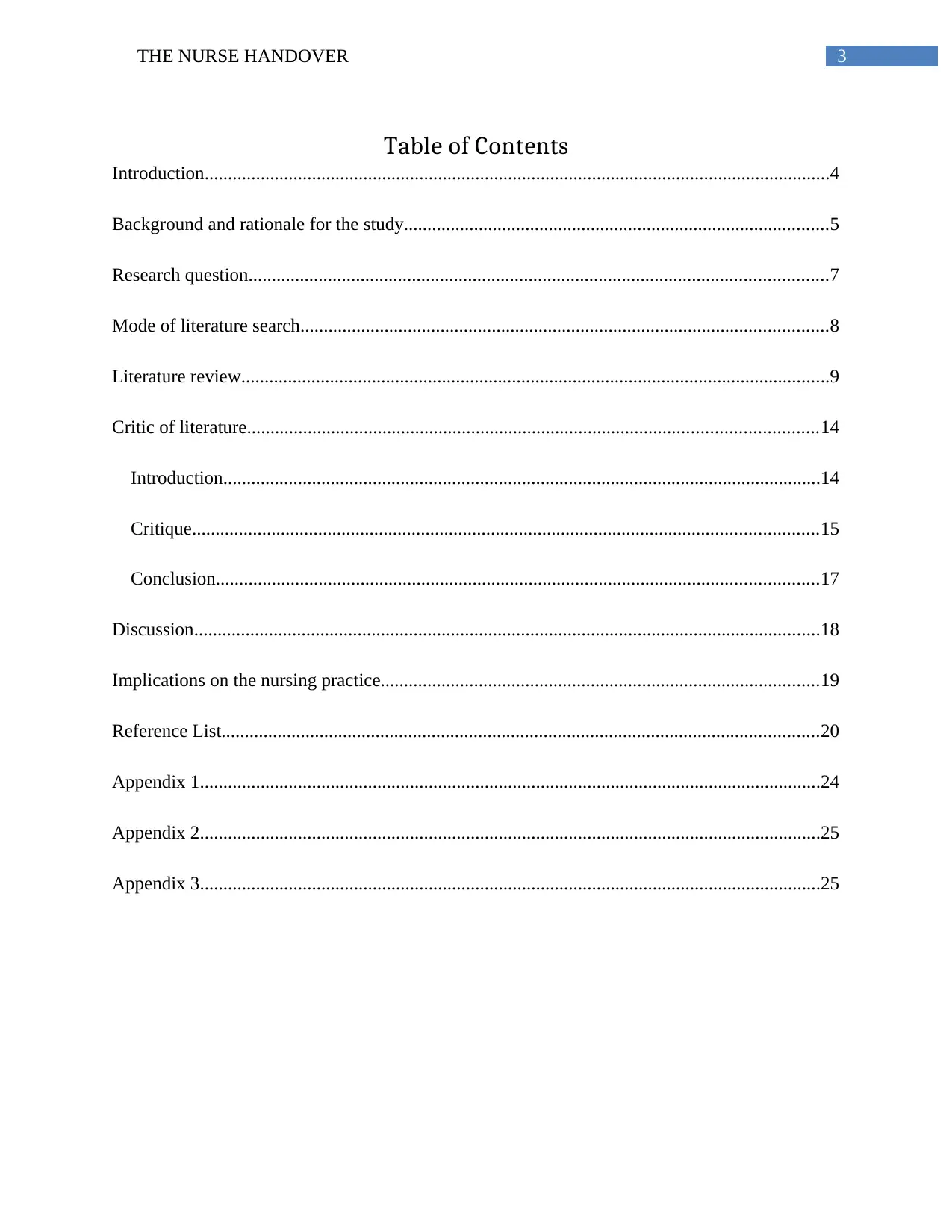
3THE NURSE HANDOVER
Table of Contents
Introduction......................................................................................................................................4
Background and rationale for the study...........................................................................................5
Research question............................................................................................................................7
Mode of literature search.................................................................................................................8
Literature review..............................................................................................................................9
Critic of literature..........................................................................................................................14
Introduction................................................................................................................................14
Critique......................................................................................................................................15
Conclusion.................................................................................................................................17
Discussion......................................................................................................................................18
Implications on the nursing practice..............................................................................................19
Reference List................................................................................................................................20
Appendix 1.....................................................................................................................................24
Appendix 2.....................................................................................................................................25
Appendix 3.....................................................................................................................................25
Table of Contents
Introduction......................................................................................................................................4
Background and rationale for the study...........................................................................................5
Research question............................................................................................................................7
Mode of literature search.................................................................................................................8
Literature review..............................................................................................................................9
Critic of literature..........................................................................................................................14
Introduction................................................................................................................................14
Critique......................................................................................................................................15
Conclusion.................................................................................................................................17
Discussion......................................................................................................................................18
Implications on the nursing practice..............................................................................................19
Reference List................................................................................................................................20
Appendix 1.....................................................................................................................................24
Appendix 2.....................................................................................................................................25
Appendix 3.....................................................................................................................................25
Paraphrase This Document
Need a fresh take? Get an instant paraphrase of this document with our AI Paraphraser
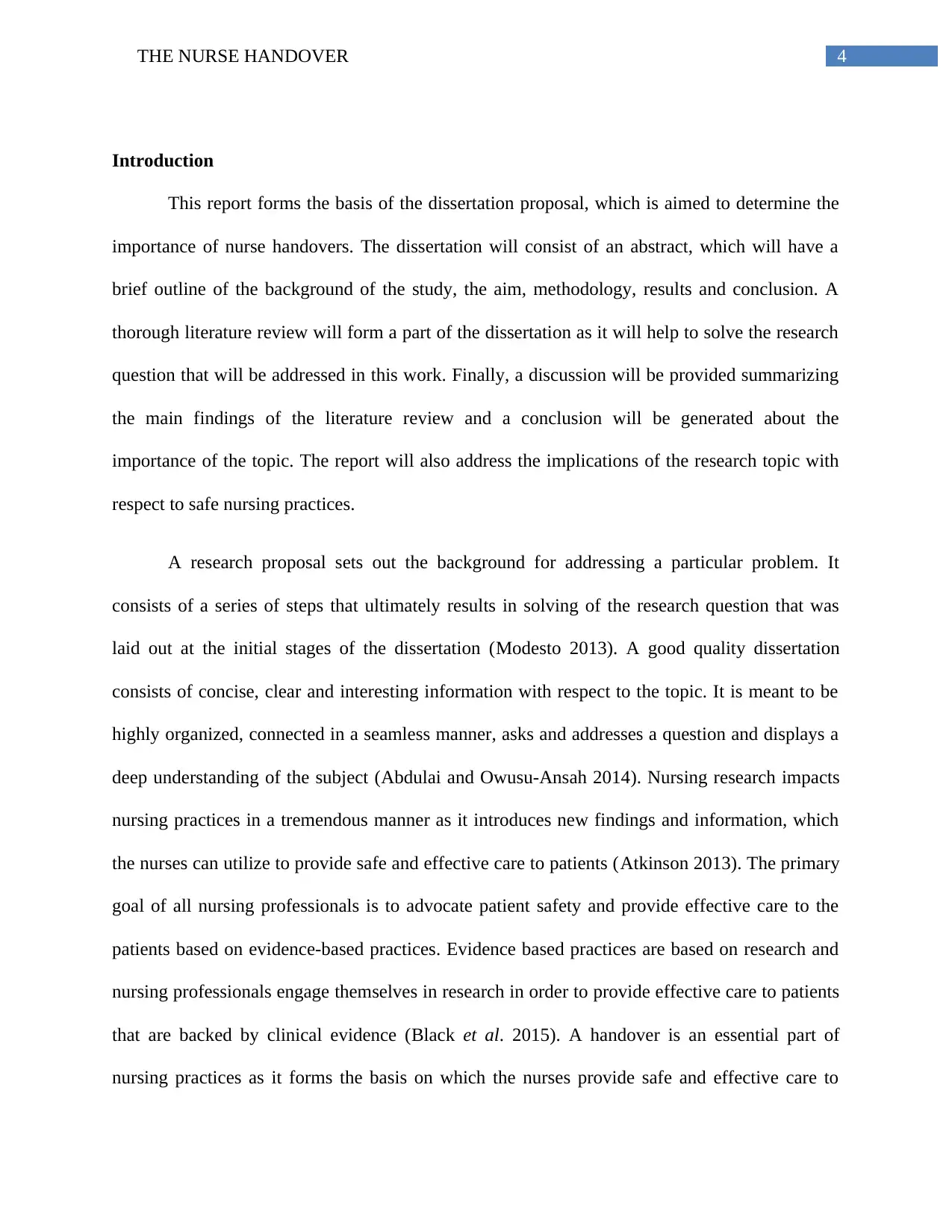
4THE NURSE HANDOVER
Introduction
This report forms the basis of the dissertation proposal, which is aimed to determine the
importance of nurse handovers. The dissertation will consist of an abstract, which will have a
brief outline of the background of the study, the aim, methodology, results and conclusion. A
thorough literature review will form a part of the dissertation as it will help to solve the research
question that will be addressed in this work. Finally, a discussion will be provided summarizing
the main findings of the literature review and a conclusion will be generated about the
importance of the topic. The report will also address the implications of the research topic with
respect to safe nursing practices.
A research proposal sets out the background for addressing a particular problem. It
consists of a series of steps that ultimately results in solving of the research question that was
laid out at the initial stages of the dissertation (Modesto 2013). A good quality dissertation
consists of concise, clear and interesting information with respect to the topic. It is meant to be
highly organized, connected in a seamless manner, asks and addresses a question and displays a
deep understanding of the subject (Abdulai and Owusu-Ansah 2014). Nursing research impacts
nursing practices in a tremendous manner as it introduces new findings and information, which
the nurses can utilize to provide safe and effective care to patients (Atkinson 2013). The primary
goal of all nursing professionals is to advocate patient safety and provide effective care to the
patients based on evidence-based practices. Evidence based practices are based on research and
nursing professionals engage themselves in research in order to provide effective care to patients
that are backed by clinical evidence (Black et al. 2015). A handover is an essential part of
nursing practices as it forms the basis on which the nurses provide safe and effective care to
Introduction
This report forms the basis of the dissertation proposal, which is aimed to determine the
importance of nurse handovers. The dissertation will consist of an abstract, which will have a
brief outline of the background of the study, the aim, methodology, results and conclusion. A
thorough literature review will form a part of the dissertation as it will help to solve the research
question that will be addressed in this work. Finally, a discussion will be provided summarizing
the main findings of the literature review and a conclusion will be generated about the
importance of the topic. The report will also address the implications of the research topic with
respect to safe nursing practices.
A research proposal sets out the background for addressing a particular problem. It
consists of a series of steps that ultimately results in solving of the research question that was
laid out at the initial stages of the dissertation (Modesto 2013). A good quality dissertation
consists of concise, clear and interesting information with respect to the topic. It is meant to be
highly organized, connected in a seamless manner, asks and addresses a question and displays a
deep understanding of the subject (Abdulai and Owusu-Ansah 2014). Nursing research impacts
nursing practices in a tremendous manner as it introduces new findings and information, which
the nurses can utilize to provide safe and effective care to patients (Atkinson 2013). The primary
goal of all nursing professionals is to advocate patient safety and provide effective care to the
patients based on evidence-based practices. Evidence based practices are based on research and
nursing professionals engage themselves in research in order to provide effective care to patients
that are backed by clinical evidence (Black et al. 2015). A handover is an essential part of
nursing practices as it forms the basis on which the nurses provide safe and effective care to
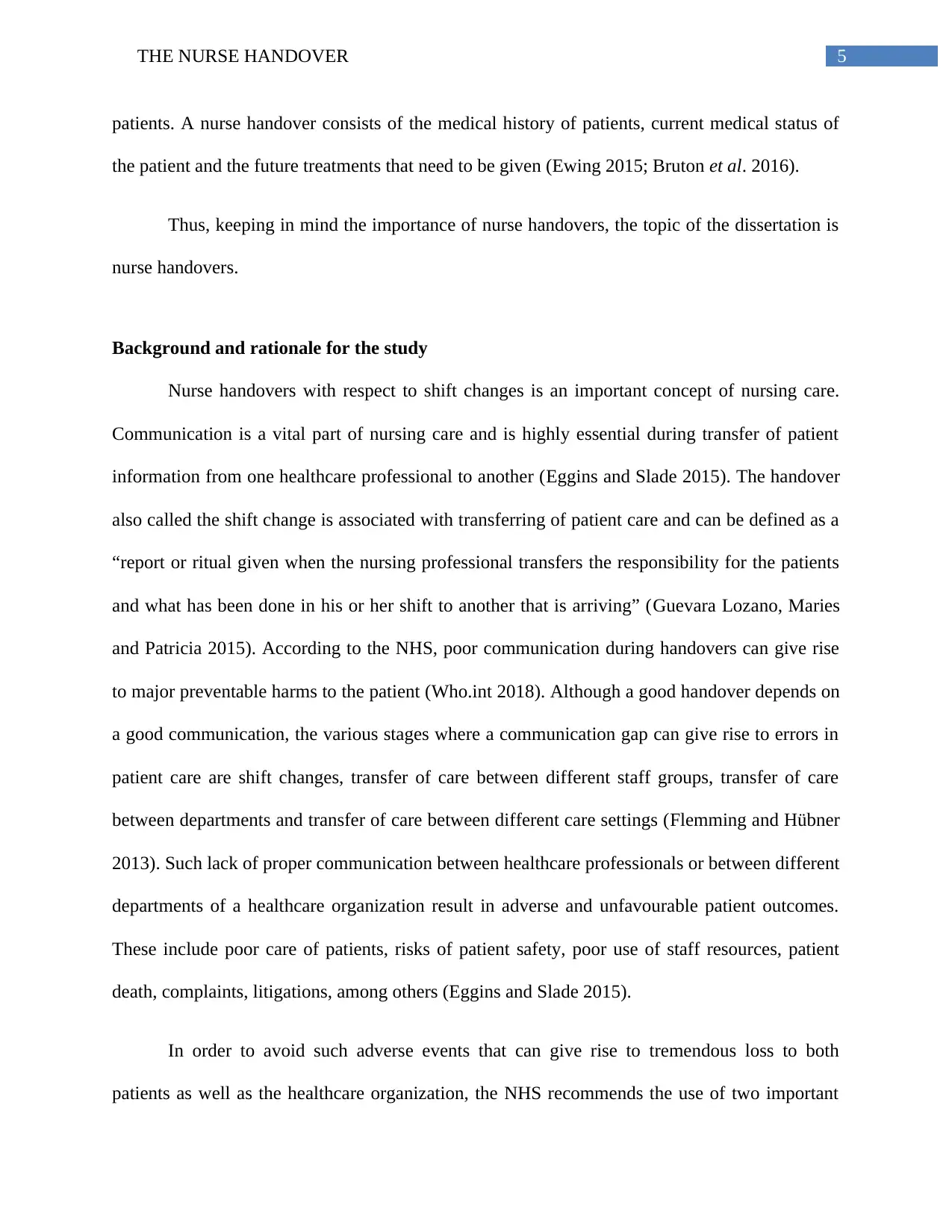
5THE NURSE HANDOVER
patients. A nurse handover consists of the medical history of patients, current medical status of
the patient and the future treatments that need to be given (Ewing 2015; Bruton et al. 2016).
Thus, keeping in mind the importance of nurse handovers, the topic of the dissertation is
nurse handovers.
Background and rationale for the study
Nurse handovers with respect to shift changes is an important concept of nursing care.
Communication is a vital part of nursing care and is highly essential during transfer of patient
information from one healthcare professional to another (Eggins and Slade 2015). The handover
also called the shift change is associated with transferring of patient care and can be defined as a
“report or ritual given when the nursing professional transfers the responsibility for the patients
and what has been done in his or her shift to another that is arriving” (Guevara Lozano, Maries
and Patricia 2015). According to the NHS, poor communication during handovers can give rise
to major preventable harms to the patient (Who.int 2018). Although a good handover depends on
a good communication, the various stages where a communication gap can give rise to errors in
patient care are shift changes, transfer of care between different staff groups, transfer of care
between departments and transfer of care between different care settings (Flemming and Hübner
2013). Such lack of proper communication between healthcare professionals or between different
departments of a healthcare organization result in adverse and unfavourable patient outcomes.
These include poor care of patients, risks of patient safety, poor use of staff resources, patient
death, complaints, litigations, among others (Eggins and Slade 2015).
In order to avoid such adverse events that can give rise to tremendous loss to both
patients as well as the healthcare organization, the NHS recommends the use of two important
patients. A nurse handover consists of the medical history of patients, current medical status of
the patient and the future treatments that need to be given (Ewing 2015; Bruton et al. 2016).
Thus, keeping in mind the importance of nurse handovers, the topic of the dissertation is
nurse handovers.
Background and rationale for the study
Nurse handovers with respect to shift changes is an important concept of nursing care.
Communication is a vital part of nursing care and is highly essential during transfer of patient
information from one healthcare professional to another (Eggins and Slade 2015). The handover
also called the shift change is associated with transferring of patient care and can be defined as a
“report or ritual given when the nursing professional transfers the responsibility for the patients
and what has been done in his or her shift to another that is arriving” (Guevara Lozano, Maries
and Patricia 2015). According to the NHS, poor communication during handovers can give rise
to major preventable harms to the patient (Who.int 2018). Although a good handover depends on
a good communication, the various stages where a communication gap can give rise to errors in
patient care are shift changes, transfer of care between different staff groups, transfer of care
between departments and transfer of care between different care settings (Flemming and Hübner
2013). Such lack of proper communication between healthcare professionals or between different
departments of a healthcare organization result in adverse and unfavourable patient outcomes.
These include poor care of patients, risks of patient safety, poor use of staff resources, patient
death, complaints, litigations, among others (Eggins and Slade 2015).
In order to avoid such adverse events that can give rise to tremendous loss to both
patients as well as the healthcare organization, the NHS recommends the use of two important
⊘ This is a preview!⊘
Do you want full access?
Subscribe today to unlock all pages.

Trusted by 1+ million students worldwide
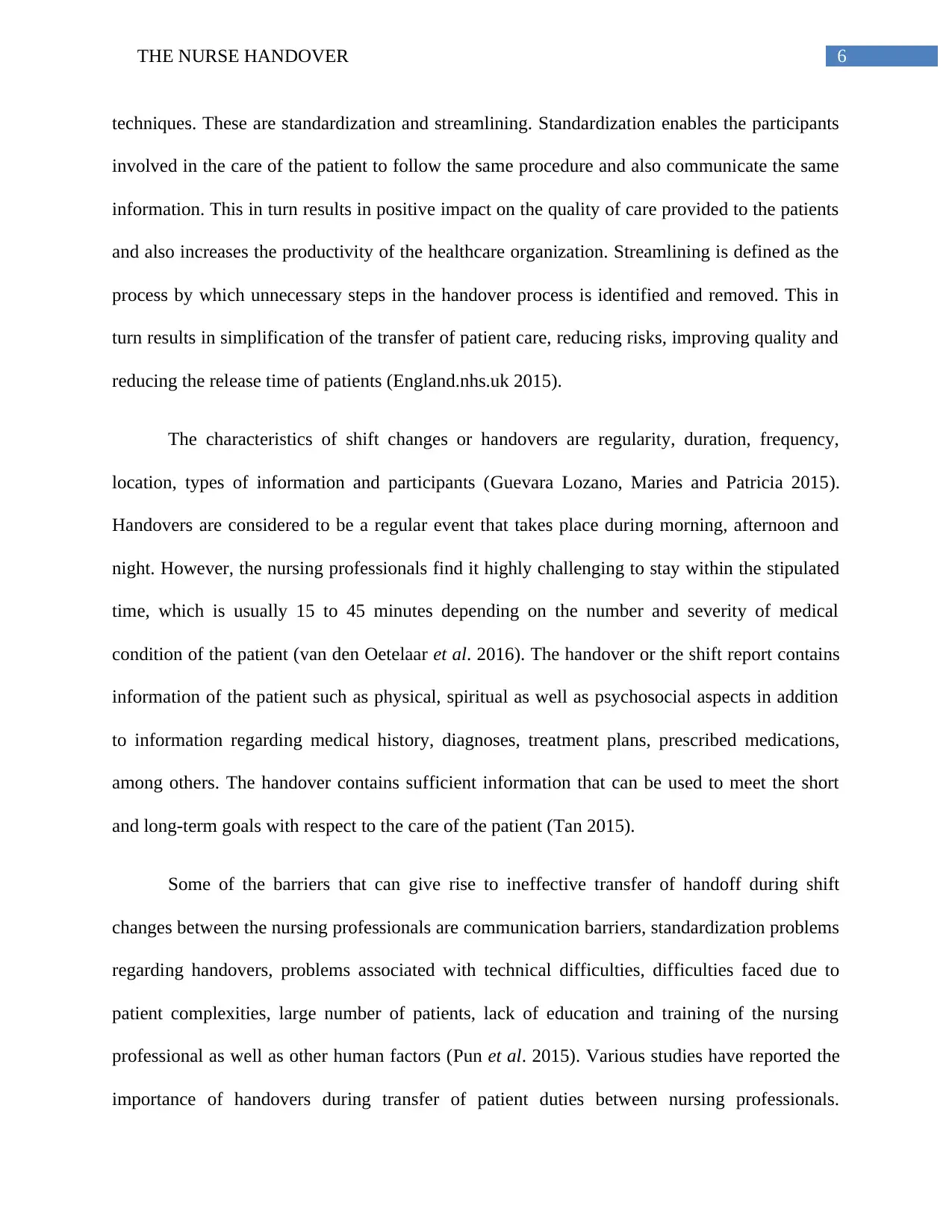
6THE NURSE HANDOVER
techniques. These are standardization and streamlining. Standardization enables the participants
involved in the care of the patient to follow the same procedure and also communicate the same
information. This in turn results in positive impact on the quality of care provided to the patients
and also increases the productivity of the healthcare organization. Streamlining is defined as the
process by which unnecessary steps in the handover process is identified and removed. This in
turn results in simplification of the transfer of patient care, reducing risks, improving quality and
reducing the release time of patients (England.nhs.uk 2015).
The characteristics of shift changes or handovers are regularity, duration, frequency,
location, types of information and participants (Guevara Lozano, Maries and Patricia 2015).
Handovers are considered to be a regular event that takes place during morning, afternoon and
night. However, the nursing professionals find it highly challenging to stay within the stipulated
time, which is usually 15 to 45 minutes depending on the number and severity of medical
condition of the patient (van den Oetelaar et al. 2016). The handover or the shift report contains
information of the patient such as physical, spiritual as well as psychosocial aspects in addition
to information regarding medical history, diagnoses, treatment plans, prescribed medications,
among others. The handover contains sufficient information that can be used to meet the short
and long-term goals with respect to the care of the patient (Tan 2015).
Some of the barriers that can give rise to ineffective transfer of handoff during shift
changes between the nursing professionals are communication barriers, standardization problems
regarding handovers, problems associated with technical difficulties, difficulties faced due to
patient complexities, large number of patients, lack of education and training of the nursing
professional as well as other human factors (Pun et al. 2015). Various studies have reported the
importance of handovers during transfer of patient duties between nursing professionals.
techniques. These are standardization and streamlining. Standardization enables the participants
involved in the care of the patient to follow the same procedure and also communicate the same
information. This in turn results in positive impact on the quality of care provided to the patients
and also increases the productivity of the healthcare organization. Streamlining is defined as the
process by which unnecessary steps in the handover process is identified and removed. This in
turn results in simplification of the transfer of patient care, reducing risks, improving quality and
reducing the release time of patients (England.nhs.uk 2015).
The characteristics of shift changes or handovers are regularity, duration, frequency,
location, types of information and participants (Guevara Lozano, Maries and Patricia 2015).
Handovers are considered to be a regular event that takes place during morning, afternoon and
night. However, the nursing professionals find it highly challenging to stay within the stipulated
time, which is usually 15 to 45 minutes depending on the number and severity of medical
condition of the patient (van den Oetelaar et al. 2016). The handover or the shift report contains
information of the patient such as physical, spiritual as well as psychosocial aspects in addition
to information regarding medical history, diagnoses, treatment plans, prescribed medications,
among others. The handover contains sufficient information that can be used to meet the short
and long-term goals with respect to the care of the patient (Tan 2015).
Some of the barriers that can give rise to ineffective transfer of handoff during shift
changes between the nursing professionals are communication barriers, standardization problems
regarding handovers, problems associated with technical difficulties, difficulties faced due to
patient complexities, large number of patients, lack of education and training of the nursing
professional as well as other human factors (Pun et al. 2015). Various studies have reported the
importance of handovers during transfer of patient duties between nursing professionals.
Paraphrase This Document
Need a fresh take? Get an instant paraphrase of this document with our AI Paraphraser
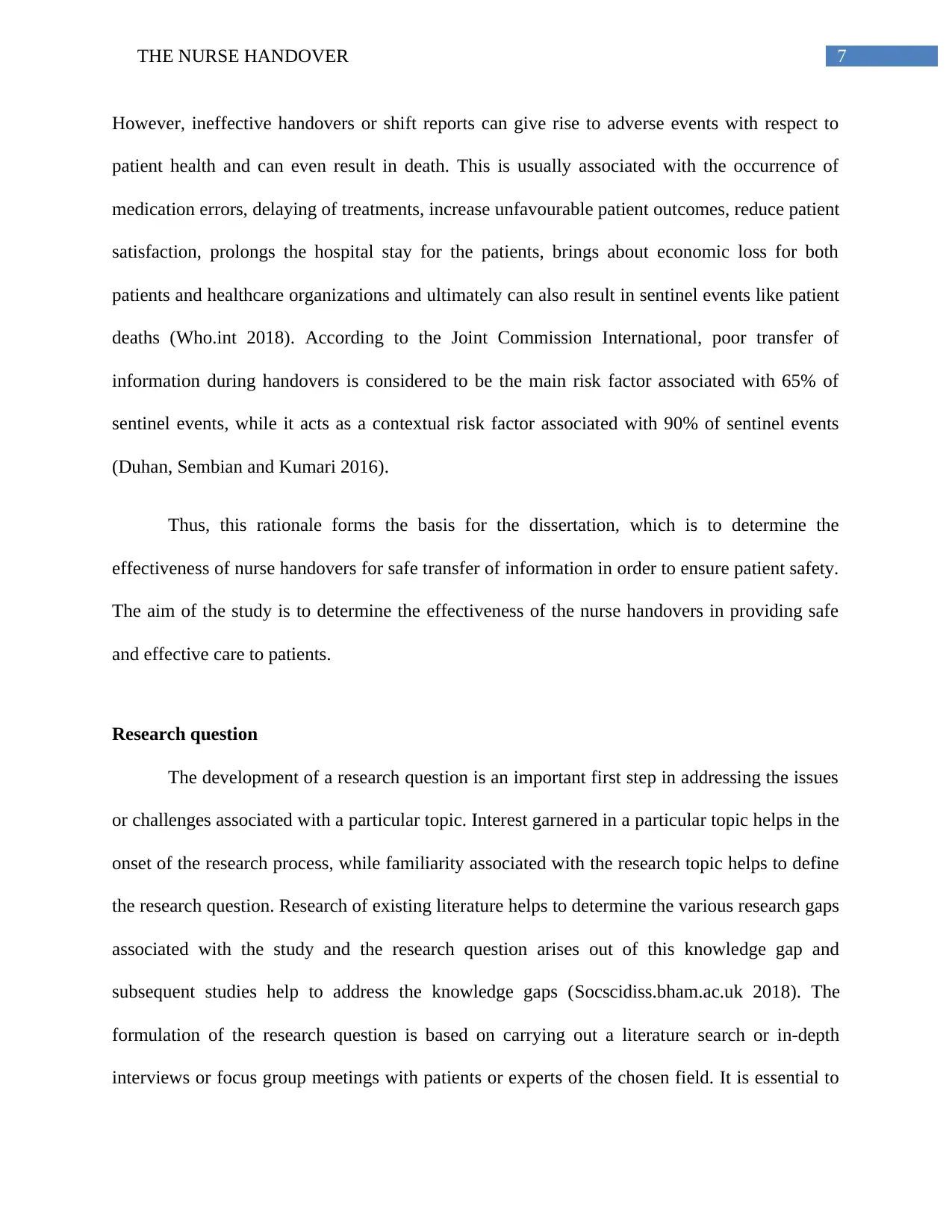
7THE NURSE HANDOVER
However, ineffective handovers or shift reports can give rise to adverse events with respect to
patient health and can even result in death. This is usually associated with the occurrence of
medication errors, delaying of treatments, increase unfavourable patient outcomes, reduce patient
satisfaction, prolongs the hospital stay for the patients, brings about economic loss for both
patients and healthcare organizations and ultimately can also result in sentinel events like patient
deaths (Who.int 2018). According to the Joint Commission International, poor transfer of
information during handovers is considered to be the main risk factor associated with 65% of
sentinel events, while it acts as a contextual risk factor associated with 90% of sentinel events
(Duhan, Sembian and Kumari 2016).
Thus, this rationale forms the basis for the dissertation, which is to determine the
effectiveness of nurse handovers for safe transfer of information in order to ensure patient safety.
The aim of the study is to determine the effectiveness of the nurse handovers in providing safe
and effective care to patients.
Research question
The development of a research question is an important first step in addressing the issues
or challenges associated with a particular topic. Interest garnered in a particular topic helps in the
onset of the research process, while familiarity associated with the research topic helps to define
the research question. Research of existing literature helps to determine the various research gaps
associated with the study and the research question arises out of this knowledge gap and
subsequent studies help to address the knowledge gaps (Socscidiss.bham.ac.uk 2018). The
formulation of the research question is based on carrying out a literature search or in-depth
interviews or focus group meetings with patients or experts of the chosen field. It is essential to
However, ineffective handovers or shift reports can give rise to adverse events with respect to
patient health and can even result in death. This is usually associated with the occurrence of
medication errors, delaying of treatments, increase unfavourable patient outcomes, reduce patient
satisfaction, prolongs the hospital stay for the patients, brings about economic loss for both
patients and healthcare organizations and ultimately can also result in sentinel events like patient
deaths (Who.int 2018). According to the Joint Commission International, poor transfer of
information during handovers is considered to be the main risk factor associated with 65% of
sentinel events, while it acts as a contextual risk factor associated with 90% of sentinel events
(Duhan, Sembian and Kumari 2016).
Thus, this rationale forms the basis for the dissertation, which is to determine the
effectiveness of nurse handovers for safe transfer of information in order to ensure patient safety.
The aim of the study is to determine the effectiveness of the nurse handovers in providing safe
and effective care to patients.
Research question
The development of a research question is an important first step in addressing the issues
or challenges associated with a particular topic. Interest garnered in a particular topic helps in the
onset of the research process, while familiarity associated with the research topic helps to define
the research question. Research of existing literature helps to determine the various research gaps
associated with the study and the research question arises out of this knowledge gap and
subsequent studies help to address the knowledge gaps (Socscidiss.bham.ac.uk 2018). The
formulation of the research question is based on carrying out a literature search or in-depth
interviews or focus group meetings with patients or experts of the chosen field. It is essential to
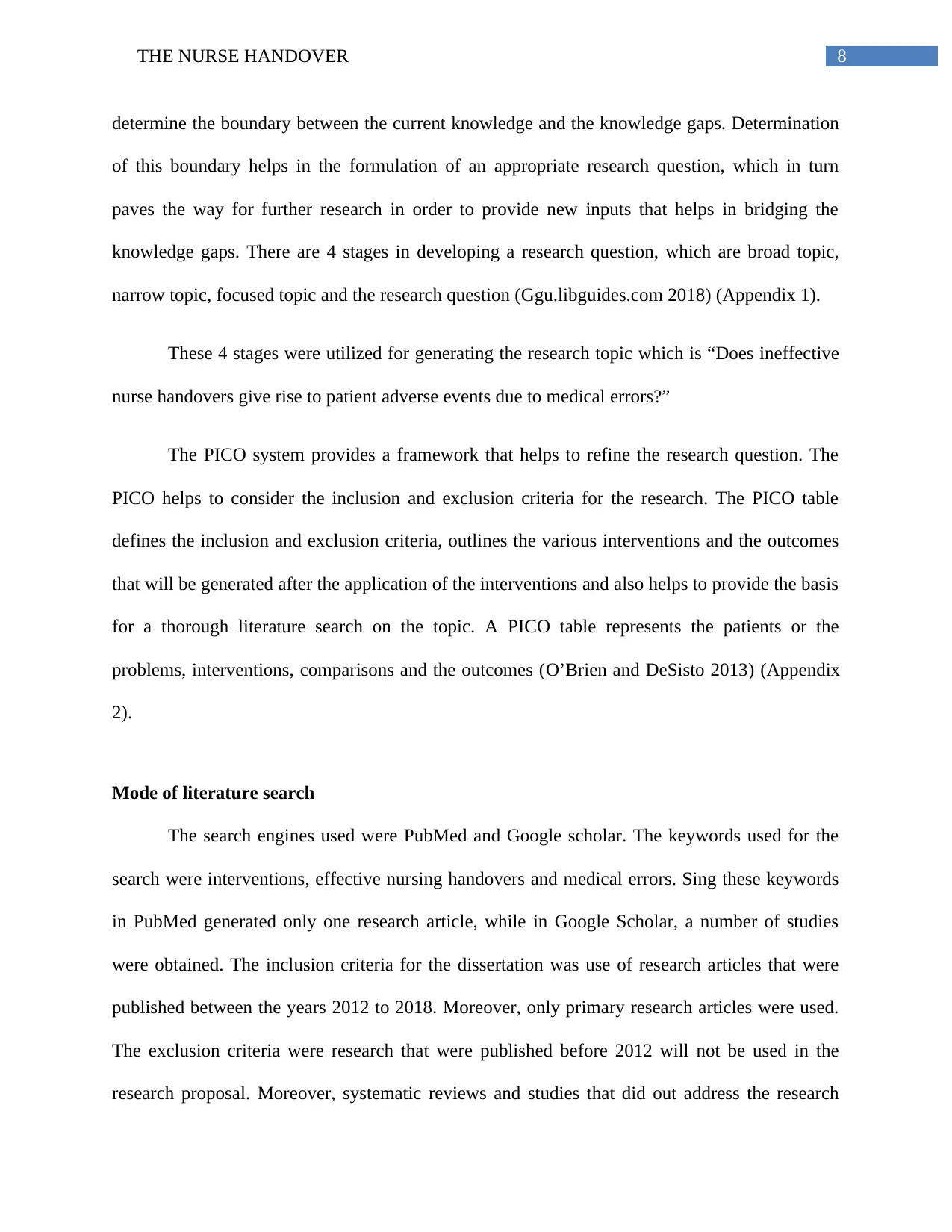
8THE NURSE HANDOVER
determine the boundary between the current knowledge and the knowledge gaps. Determination
of this boundary helps in the formulation of an appropriate research question, which in turn
paves the way for further research in order to provide new inputs that helps in bridging the
knowledge gaps. There are 4 stages in developing a research question, which are broad topic,
narrow topic, focused topic and the research question (Ggu.libguides.com 2018) (Appendix 1).
These 4 stages were utilized for generating the research topic which is “Does ineffective
nurse handovers give rise to patient adverse events due to medical errors?”
The PICO system provides a framework that helps to refine the research question. The
PICO helps to consider the inclusion and exclusion criteria for the research. The PICO table
defines the inclusion and exclusion criteria, outlines the various interventions and the outcomes
that will be generated after the application of the interventions and also helps to provide the basis
for a thorough literature search on the topic. A PICO table represents the patients or the
problems, interventions, comparisons and the outcomes (O’Brien and DeSisto 2013) (Appendix
2).
Mode of literature search
The search engines used were PubMed and Google scholar. The keywords used for the
search were interventions, effective nursing handovers and medical errors. Sing these keywords
in PubMed generated only one research article, while in Google Scholar, a number of studies
were obtained. The inclusion criteria for the dissertation was use of research articles that were
published between the years 2012 to 2018. Moreover, only primary research articles were used.
The exclusion criteria were research that were published before 2012 will not be used in the
research proposal. Moreover, systematic reviews and studies that did out address the research
determine the boundary between the current knowledge and the knowledge gaps. Determination
of this boundary helps in the formulation of an appropriate research question, which in turn
paves the way for further research in order to provide new inputs that helps in bridging the
knowledge gaps. There are 4 stages in developing a research question, which are broad topic,
narrow topic, focused topic and the research question (Ggu.libguides.com 2018) (Appendix 1).
These 4 stages were utilized for generating the research topic which is “Does ineffective
nurse handovers give rise to patient adverse events due to medical errors?”
The PICO system provides a framework that helps to refine the research question. The
PICO helps to consider the inclusion and exclusion criteria for the research. The PICO table
defines the inclusion and exclusion criteria, outlines the various interventions and the outcomes
that will be generated after the application of the interventions and also helps to provide the basis
for a thorough literature search on the topic. A PICO table represents the patients or the
problems, interventions, comparisons and the outcomes (O’Brien and DeSisto 2013) (Appendix
2).
Mode of literature search
The search engines used were PubMed and Google scholar. The keywords used for the
search were interventions, effective nursing handovers and medical errors. Sing these keywords
in PubMed generated only one research article, while in Google Scholar, a number of studies
were obtained. The inclusion criteria for the dissertation was use of research articles that were
published between the years 2012 to 2018. Moreover, only primary research articles were used.
The exclusion criteria were research that were published before 2012 will not be used in the
research proposal. Moreover, systematic reviews and studies that did out address the research
⊘ This is a preview!⊘
Do you want full access?
Subscribe today to unlock all pages.

Trusted by 1+ million students worldwide
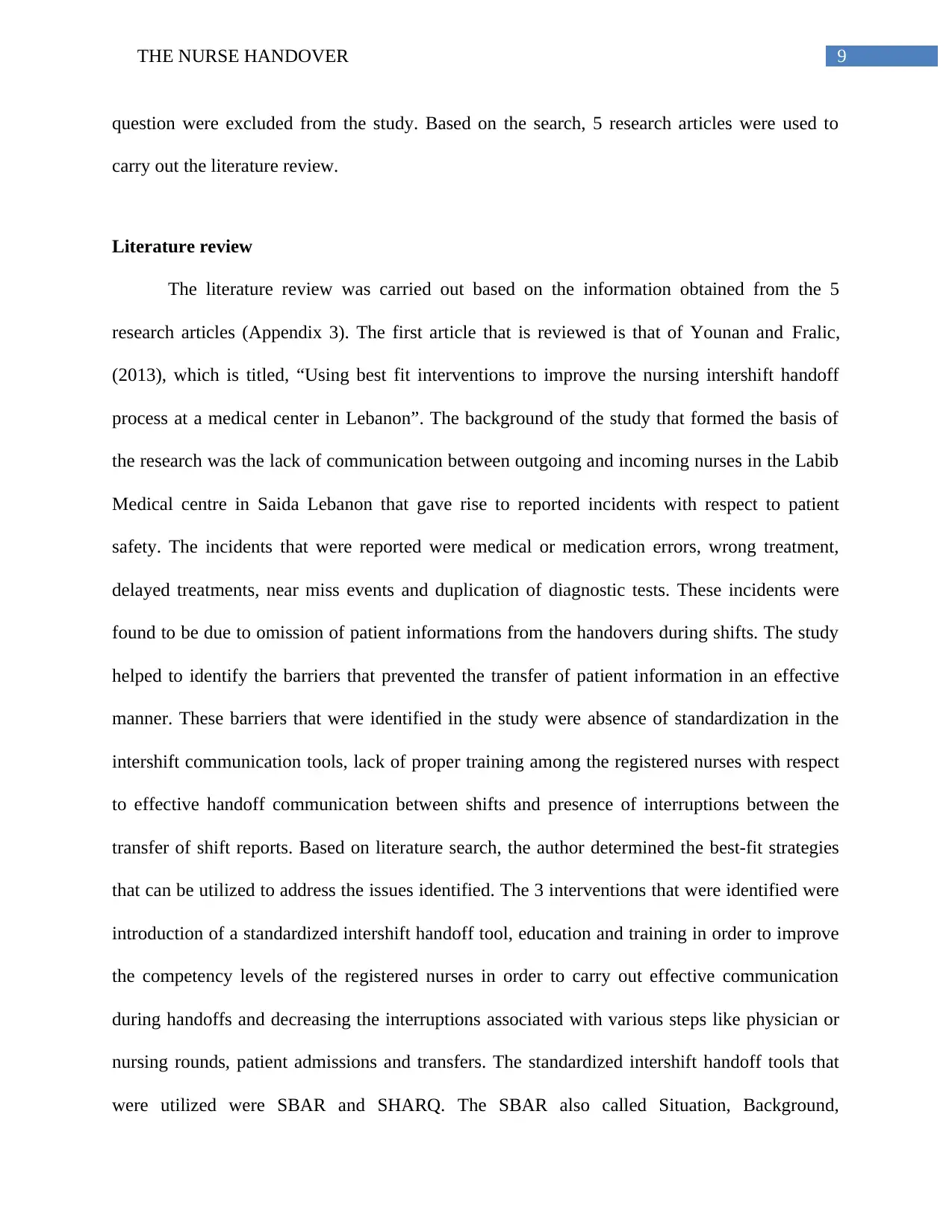
9THE NURSE HANDOVER
question were excluded from the study. Based on the search, 5 research articles were used to
carry out the literature review.
Literature review
The literature review was carried out based on the information obtained from the 5
research articles (Appendix 3). The first article that is reviewed is that of Younan and Fralic,
(2013), which is titled, “Using best fit interventions to improve the nursing intershift handoff
process at a medical center in Lebanon”. The background of the study that formed the basis of
the research was the lack of communication between outgoing and incoming nurses in the Labib
Medical centre in Saida Lebanon that gave rise to reported incidents with respect to patient
safety. The incidents that were reported were medical or medication errors, wrong treatment,
delayed treatments, near miss events and duplication of diagnostic tests. These incidents were
found to be due to omission of patient informations from the handovers during shifts. The study
helped to identify the barriers that prevented the transfer of patient information in an effective
manner. These barriers that were identified in the study were absence of standardization in the
intershift communication tools, lack of proper training among the registered nurses with respect
to effective handoff communication between shifts and presence of interruptions between the
transfer of shift reports. Based on literature search, the author determined the best-fit strategies
that can be utilized to address the issues identified. The 3 interventions that were identified were
introduction of a standardized intershift handoff tool, education and training in order to improve
the competency levels of the registered nurses in order to carry out effective communication
during handoffs and decreasing the interruptions associated with various steps like physician or
nursing rounds, patient admissions and transfers. The standardized intershift handoff tools that
were utilized were SBAR and SHARQ. The SBAR also called Situation, Background,
question were excluded from the study. Based on the search, 5 research articles were used to
carry out the literature review.
Literature review
The literature review was carried out based on the information obtained from the 5
research articles (Appendix 3). The first article that is reviewed is that of Younan and Fralic,
(2013), which is titled, “Using best fit interventions to improve the nursing intershift handoff
process at a medical center in Lebanon”. The background of the study that formed the basis of
the research was the lack of communication between outgoing and incoming nurses in the Labib
Medical centre in Saida Lebanon that gave rise to reported incidents with respect to patient
safety. The incidents that were reported were medical or medication errors, wrong treatment,
delayed treatments, near miss events and duplication of diagnostic tests. These incidents were
found to be due to omission of patient informations from the handovers during shifts. The study
helped to identify the barriers that prevented the transfer of patient information in an effective
manner. These barriers that were identified in the study were absence of standardization in the
intershift communication tools, lack of proper training among the registered nurses with respect
to effective handoff communication between shifts and presence of interruptions between the
transfer of shift reports. Based on literature search, the author determined the best-fit strategies
that can be utilized to address the issues identified. The 3 interventions that were identified were
introduction of a standardized intershift handoff tool, education and training in order to improve
the competency levels of the registered nurses in order to carry out effective communication
during handoffs and decreasing the interruptions associated with various steps like physician or
nursing rounds, patient admissions and transfers. The standardized intershift handoff tools that
were utilized were SBAR and SHARQ. The SBAR also called Situation, Background,
Paraphrase This Document
Need a fresh take? Get an instant paraphrase of this document with our AI Paraphraser
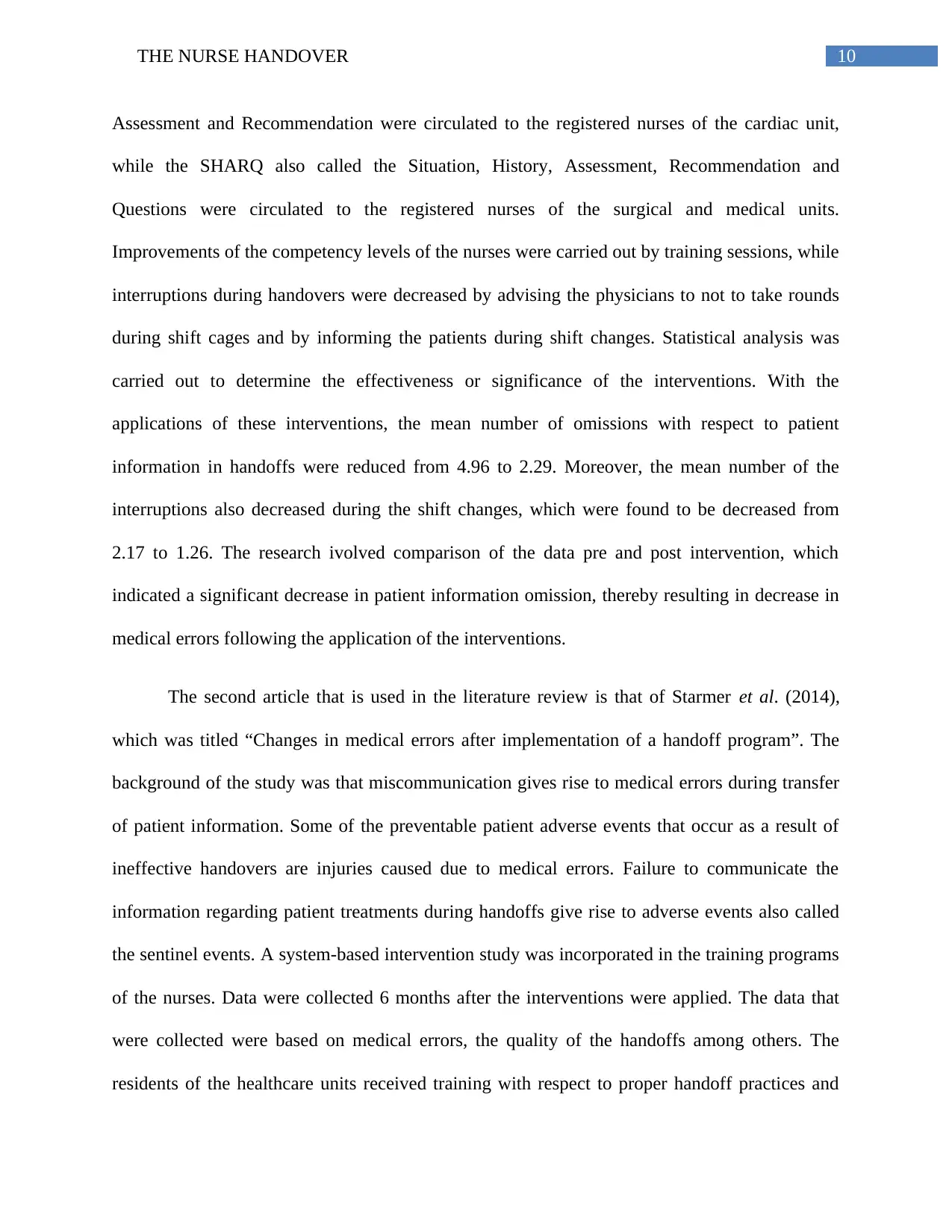
10THE NURSE HANDOVER
Assessment and Recommendation were circulated to the registered nurses of the cardiac unit,
while the SHARQ also called the Situation, History, Assessment, Recommendation and
Questions were circulated to the registered nurses of the surgical and medical units.
Improvements of the competency levels of the nurses were carried out by training sessions, while
interruptions during handovers were decreased by advising the physicians to not to take rounds
during shift cages and by informing the patients during shift changes. Statistical analysis was
carried out to determine the effectiveness or significance of the interventions. With the
applications of these interventions, the mean number of omissions with respect to patient
information in handoffs were reduced from 4.96 to 2.29. Moreover, the mean number of the
interruptions also decreased during the shift changes, which were found to be decreased from
2.17 to 1.26. The research ivolved comparison of the data pre and post intervention, which
indicated a significant decrease in patient information omission, thereby resulting in decrease in
medical errors following the application of the interventions.
The second article that is used in the literature review is that of Starmer et al. (2014),
which was titled “Changes in medical errors after implementation of a handoff program”. The
background of the study was that miscommunication gives rise to medical errors during transfer
of patient information. Some of the preventable patient adverse events that occur as a result of
ineffective handovers are injuries caused due to medical errors. Failure to communicate the
information regarding patient treatments during handoffs give rise to adverse events also called
the sentinel events. A system-based intervention study was incorporated in the training programs
of the nurses. Data were collected 6 months after the interventions were applied. The data that
were collected were based on medical errors, the quality of the handoffs among others. The
residents of the healthcare units received training with respect to proper handoff practices and
Assessment and Recommendation were circulated to the registered nurses of the cardiac unit,
while the SHARQ also called the Situation, History, Assessment, Recommendation and
Questions were circulated to the registered nurses of the surgical and medical units.
Improvements of the competency levels of the nurses were carried out by training sessions, while
interruptions during handovers were decreased by advising the physicians to not to take rounds
during shift cages and by informing the patients during shift changes. Statistical analysis was
carried out to determine the effectiveness or significance of the interventions. With the
applications of these interventions, the mean number of omissions with respect to patient
information in handoffs were reduced from 4.96 to 2.29. Moreover, the mean number of the
interruptions also decreased during the shift changes, which were found to be decreased from
2.17 to 1.26. The research ivolved comparison of the data pre and post intervention, which
indicated a significant decrease in patient information omission, thereby resulting in decrease in
medical errors following the application of the interventions.
The second article that is used in the literature review is that of Starmer et al. (2014),
which was titled “Changes in medical errors after implementation of a handoff program”. The
background of the study was that miscommunication gives rise to medical errors during transfer
of patient information. Some of the preventable patient adverse events that occur as a result of
ineffective handovers are injuries caused due to medical errors. Failure to communicate the
information regarding patient treatments during handoffs give rise to adverse events also called
the sentinel events. A system-based intervention study was incorporated in the training programs
of the nurses. Data were collected 6 months after the interventions were applied. The data that
were collected were based on medical errors, the quality of the handoffs among others. The
residents of the healthcare units received training with respect to proper handoff practices and
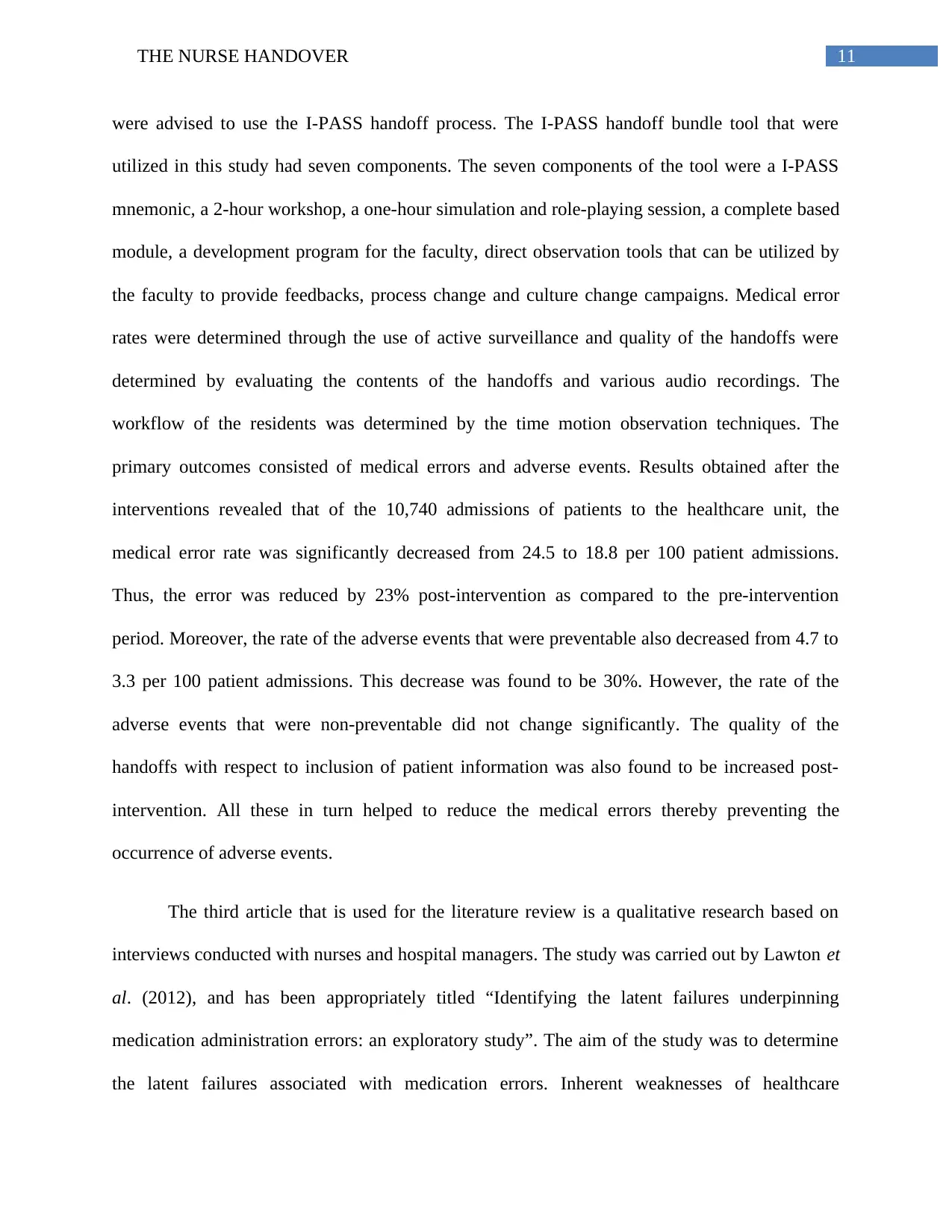
11THE NURSE HANDOVER
were advised to use the I-PASS handoff process. The I-PASS handoff bundle tool that were
utilized in this study had seven components. The seven components of the tool were a I-PASS
mnemonic, a 2-hour workshop, a one-hour simulation and role-playing session, a complete based
module, a development program for the faculty, direct observation tools that can be utilized by
the faculty to provide feedbacks, process change and culture change campaigns. Medical error
rates were determined through the use of active surveillance and quality of the handoffs were
determined by evaluating the contents of the handoffs and various audio recordings. The
workflow of the residents was determined by the time motion observation techniques. The
primary outcomes consisted of medical errors and adverse events. Results obtained after the
interventions revealed that of the 10,740 admissions of patients to the healthcare unit, the
medical error rate was significantly decreased from 24.5 to 18.8 per 100 patient admissions.
Thus, the error was reduced by 23% post-intervention as compared to the pre-intervention
period. Moreover, the rate of the adverse events that were preventable also decreased from 4.7 to
3.3 per 100 patient admissions. This decrease was found to be 30%. However, the rate of the
adverse events that were non-preventable did not change significantly. The quality of the
handoffs with respect to inclusion of patient information was also found to be increased post-
intervention. All these in turn helped to reduce the medical errors thereby preventing the
occurrence of adverse events.
The third article that is used for the literature review is a qualitative research based on
interviews conducted with nurses and hospital managers. The study was carried out by Lawton et
al. (2012), and has been appropriately titled “Identifying the latent failures underpinning
medication administration errors: an exploratory study”. The aim of the study was to determine
the latent failures associated with medication errors. Inherent weaknesses of healthcare
were advised to use the I-PASS handoff process. The I-PASS handoff bundle tool that were
utilized in this study had seven components. The seven components of the tool were a I-PASS
mnemonic, a 2-hour workshop, a one-hour simulation and role-playing session, a complete based
module, a development program for the faculty, direct observation tools that can be utilized by
the faculty to provide feedbacks, process change and culture change campaigns. Medical error
rates were determined through the use of active surveillance and quality of the handoffs were
determined by evaluating the contents of the handoffs and various audio recordings. The
workflow of the residents was determined by the time motion observation techniques. The
primary outcomes consisted of medical errors and adverse events. Results obtained after the
interventions revealed that of the 10,740 admissions of patients to the healthcare unit, the
medical error rate was significantly decreased from 24.5 to 18.8 per 100 patient admissions.
Thus, the error was reduced by 23% post-intervention as compared to the pre-intervention
period. Moreover, the rate of the adverse events that were preventable also decreased from 4.7 to
3.3 per 100 patient admissions. This decrease was found to be 30%. However, the rate of the
adverse events that were non-preventable did not change significantly. The quality of the
handoffs with respect to inclusion of patient information was also found to be increased post-
intervention. All these in turn helped to reduce the medical errors thereby preventing the
occurrence of adverse events.
The third article that is used for the literature review is a qualitative research based on
interviews conducted with nurses and hospital managers. The study was carried out by Lawton et
al. (2012), and has been appropriately titled “Identifying the latent failures underpinning
medication administration errors: an exploratory study”. The aim of the study was to determine
the latent failures associated with medication errors. Inherent weaknesses of healthcare
⊘ This is a preview!⊘
Do you want full access?
Subscribe today to unlock all pages.

Trusted by 1+ million students worldwide
1 out of 28
Related Documents
Your All-in-One AI-Powered Toolkit for Academic Success.
+13062052269
info@desklib.com
Available 24*7 on WhatsApp / Email
![[object Object]](/_next/static/media/star-bottom.7253800d.svg)
Unlock your academic potential
Copyright © 2020–2025 A2Z Services. All Rights Reserved. Developed and managed by ZUCOL.





